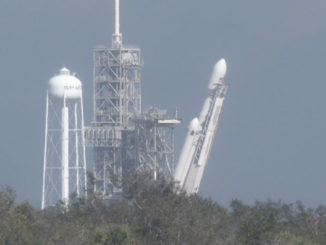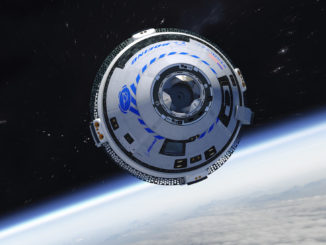
On the eve of the 10th anniversary of the Falcon 9 rocket’s debut flight, SpaceX launched a Falcon 9 from Cape Canaveral with a reused first stage Wednesday, then landed the previously-flown booster for a record fifth time after sending 60 more Starlink Internet satellites into space.
The 229-foot-tall (70-meter) Falcon 9 rocket lifted off from pad 40 at Cape Canaveral Air Force Station at 9:25 p.m. EDT Wednesday (0125 GMT Thursday).
Nine Merlin 1D engines lit the sky orange as the Falcon 9 rocket climbed into an overcast sky over Florida’s Space Coast with 1.7 million pounds of ground-shaking thrust. Two-and-a-half minutes later, the first stage turned off its engines and dropped away to head for a pinpoint touchdown on SpaceX’s offshore landing platform, or drone ship.
The rocket’s upper stage fired into orbit with the 60 Starlink satellites, and then released all of the flat-panel spacecraft at one time around 15 minutes after liftoff in a preliminary elliptical orbit. The satellites were expected to deploy their solar arrays and spread out before beginning orbit-raising maneuvers to enter SpaceX’s Starlink constellation around 341 miles (550 kilometers) above Earth.
The launch Wednesday came a little more than four days after SpaceX’s previous launch from the Florida spaceport.
A different Falcon 9 rocket took off Saturday from pad 39A at the Kennedy Space Center — a few miles north of pad 40 — with SpaceX’s Crew Dragon spacecraft carrying NASA astronauts Doug Hurley and Bob Behnken to the International Space Station. The launch Saturday was the first time astronauts flew into orbit from U.S. soil since the final liftoff of the space shuttle program July 8, 2011.
Hurley and Behnken docked with the space station aboard their Crew Dragon capsule Sunday, and the Falcon 9 booster that carried them aloft returned to Port Canaveral Tuesday after landing on SpaceX’s ocean-going rocket recovery vessel named “Of Course I Still Love You.”
SpaceX’s other rocket retrieval drone ship, named “Just Read the Instructions,” was dispatched into the Atlantic Ocean before the other landing platform made it back to the Florida Coast with the booster from the Crew Dragon launch.
The drone ship Just Read the Instructions, or JRTI, was used for a rocket landing off Florida’s coast for the first time Wednesday night, following a transit from California after supporting a series of Falcon 9 missions from Vandenberg Air Force Base, the primary launch site on the U.S. West Coast.
After detaching from the Falcon 9’s upper stage and the rocket’s payload stack of 60 Starlink spacecraft, the 15-story-tall first stage booster maneuvered using thrusters to fly tail first, extended four stabilizing aerodynamic grid fins, and plunged back into the thick, lower atmosphere.
An entry burn using three of the first stage’s Merlin engines helped target the booster for landing on the drone ship, positioned in the Atlantic Ocean roughly 230 miles (370 kilometers) east of Charleston, South Carolina. The rocket’s center engine fired just before reaching the vessel, and four carbon fiber landing legs extended as the booster touched down on the drone ship.
With the entry into service of a second drone ship in Florida, SpaceX can remove one hurdle to achieving a faster cadence of missions from its two launch pads on the Space Coast.
The Falcon 9 rocket’s first stage used on tonight’s launch has landed on SpaceX’s drone ship “Just Read the Instructions” in the Atlantic Ocean.
This marks the first time a Falcon 9 booster has successfully launched and landed five times. https://t.co/MD92AjUx23 pic.twitter.com/gy70hezt1J
— Spaceflight Now (@SpaceflightNow) June 4, 2020
Wednesday night’s launch of 60 more Starlink satellites was delayed from last month after Tropical Storm Arthur brought high winds and rough seas to the downrange recovery area northeast of Cape Canaveral in the Atlantic Ocean, where SpaceX’s drone ship needed to be positioned for landing of the Falcon 9’s first stage booster.
SpaceX decided to use the drone ship Of Course I Still Love You — originally deployed into the Atlantic for the Starlink launch — to recover the Falcon 9 first stage from the Crew Dragon mission.
With a single operational drone ship, SpaceX would require more than a week between Falcon 9 flights from different pads at Cape Canaveral, and still be able to retrieve both boosters for future flights. With two drone ships, SpaceX has demonstrated the capability to launch two Falcon 9 rockets from Florida and recover both boosters in a span of four days.
Two additional SpaceX vessels were in the Atlantic Ocean for Wednesday night’s launch to attempt to catch the two halves of the Falcon 9 rocket’s payload fairing, the aerodynamic shroud the shields satellites during the first few minutes of flight. Once in space, the Falcon 9 sheds the fairing halves to fall back to Earth with the aid of parafoils.
SpaceX has two ships equipped with giant nets to try to catch the fairings as they come back to Earth.
The booster and fairing recovery efforts pursued by SpaceX are unique the launch industry, and SpaceX made it a reality after a series of trial-and-error experiments and step-by-step redesigns of the Falcon 9 rocket.
SpaceX launched its first Falcon 9 rocket on a test flight 10 years ago Thursday from pad 40, the same launch complex that served as the departure point for Wednesday night’s mission.
Spaceflight Now covered the first Falcon 9 launch in 2010. Read our story from that day.

The launch Wednesday night marked the 86th flight of a Falcon 9 rocket since its debut in June 2010, and the ninth Falcon 9 launch so far in 2020.
While the Falcon 9 still uses the same fundamental launch architecture as the first version of the rocket in 2010, SpaceX has revamped numerous technological details. For example, the Falcon 9’s Merlin engines have gone through multiple upgrades to produce more thrust, and SpaceX stretched the length of the rocket’s kerosene and liquid oxygen propellant tanks to gain performance.
When those upgrades proved not enough, SpaceX began loading liquid propellants into the Falcon 9 that are chilled closer to their freezing temperature. The change, known as propellant densification, allowed engineers to cram more propellants into the Falcon 9 to further improve its lift capacity.
There have also been changes to make the Falcon 9 reliable enough to carry astronauts, as the rocket did for the first time Saturday. And SpaceX has redesigned parts of the rocket’s helium pressurization system to address the causes of two catastrophic failures — one in flight in 2015 and another on the launch pad in 2016 — that destroyed a pair of Falcon 9 rockets and their payloads.
But the most dramatic change to the Falcon 9’s design since 2010 has been in how SpaceX lands and reuses the first stage boosters.
SpaceX originally hoped to use a parachute to slow down returning rocket boosters for a gentle splashdown at sea. When that didn’t work, engineers devised a way to land the rocket vertically using variable thrust from the booster’s throttleable Merlin engines.
In some cases, when a satellite payload is light enough, the Falcon 9 first stage carries enough reserve propellant to reverse course and return to an onshore landing pad near the launch site. In cases where a payload is heavier, or if a satellite needs more energy from the Falcon 9 to go to a more distant orbit, the Falcon 9 booster arcs toward a landing on a downrange drone ship after releasing the rocket’s upper stage to continue the push into space.
Avoiding a splashdown in the ocean ensures sensitive engine components are not exposed to corrosive salt water, easing refurbishment and reuse.
SpaceX installed landing lets, aerodynamic fins and a heat shield on Falcon 9 boosters to make the recovery experiments a success. The company first recovered a Falcon 9 first stage intact on a land-based pad in December 2015, then successfully landed on a drone ship at sea for the first time in April 2016.
With Wednesday night’s booster landing, SpaceX has recovered 53 Falcon rockets, including boosters used on the company’s triple-body Falcon Heavy launcher.
The achievements have allowed SpaceX to reduce its launch costs — in some cases below $50 million — and caused rival launch providers to change plans, cut prices, and develop new rockets to try to compete with the Falcon 9.
SpaceX has won commercial business that previously went to international launch companies, and the company is now certified to launch NASA astronauts and sensitive U.S. military satellites.
Although SpaceX’s relatively low launch prices compared to competitors has lured customers from around the world, the bulk of the Falcon 9 flights in recent months have been dedicated to the company’s own satellite constellation.
The Starlink fleet could eventually number tens of thousands of satellites to beam broadband Internet services to customers lacking reliable, high-speed connectivity via terrestrial networks. Designed for low-latency broadband links, the Starlink network could be used by rural customers, support schools, hospitals and businesses in developing countries, and provide service to the U.S. military.
Starlink deployment confirmed! This video from aboard the Falcon 9 upper stage shows the release of retention rods holding the Starlink broadband satellites on the rocket.
That allowed the 60 flat-panel satellites to fly free of the launcher in orbit.https://t.co/MD92AjUx23 pic.twitter.com/RbKex5FTev
— Spaceflight Now (@SpaceflightNow) June 4, 2020
With Wednesday’s flight, SpaceX has launched 480 Starlink satellites on eight dedicated Falcon 9 missions since May 2010.
SpaceX aims to launch around 1,000 more Starlink satellites later this year and next year to begin offering worldwide Internet service. Initial beta testing of the Starlink network could begin later this year, beginning in higher latitude regions like Canada and the northern United States, the company says.
Thousands more Starlink spacecraft could launch in the coming years to meet global demand, according to SpaceX.
A new sunshade to reduce the brightness of the Starlink satellites was also due to be demonstrated on one of the spacecraft on Wednesday night’s launch. The umbrella-like visor will block sunlight from reaching the shiniest parts of the flat-panel spacecraft, making them less visible from the ground.
Scientists have raised concerns that thousands of Starlink satellites — as envisioned by SpaceX — could impact astronomical observations through ground-based telescopes. So far, SpaceX has answered with an experimental darkening treatment that offered some reduction in visibility, and the company says it is changing the orientation of the Starlink satellites during the period shortly after launch to turn their solar panels away from the sun.
The sunshade should provide a more significant dimming effect, SpaceX says.
With Wednesday night’s mission in the books, SpaceX plans two more Falcon 9 launches later this month from pad 40 and pad 39A to deliver more Starlink satellites into orbit from Cape Canaveral. SpaceX is also gearing up for the launch of a U.S. military GPS navigation satellite from pad 40 no earlier than June 30.
Email the author.
Follow Stephen Clark on Twitter: @StephenClark1.



